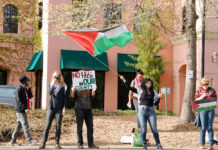GMO Clarity
The coming vote on our Growth Management Ordinance (GMO) will resolve fundamental issues affecting Healdsburg’s character and direction. The key issues are important, and a look at the city’s 16-year experience under the GMO, in every possible economic environment, from boom to recession, makes those issues stark and clear.
The GMO thwarts moderate-income housing: If Healdsburg wants to be resilient, it needs a range of housing. We have built or permitted hundreds of high-priced single family houses since the GMO was passed, and over a hundred affordable units.
But in the 16 years under the GMO, no market-rate multi-family rental housing has been built. Nothing. Why? That kind of housing – housing for city workers, young people, new families – must be built altogether and in relatively large numbers to keep the cost per unit down. Such projects require long lead times, substantial upfront investment and substantial commitments to lenders before a developer can start work.
Developers cannot firmly commit to build large projects years in the future, and the city is understandably reluctant to allocate limited GMO slots without firm commitments, because, under our GMO, those slots are permanently lost if not used. Healdsburg is in every multi-family builder’s “too hard” basket – they can go to Windsor or Rohnert Park and build there. And they do.
If we keep the GMO, we’ll get precisely the city we don’t want: Our history with the GMO tells us just what the future holds if we don’t change the current rules. While the proponents of the GMO want a more livable city, with less emphasis on tourism, they are embracing the very tool that blocks those goals.
If we keep the GMO, we’ll get more high-priced housing like the developments across from Big O Tires on Healdsburg Avenue and the one behind the firehouse. We’ll get some affordable housing, but not enough to make a serious dent in the need. In the key downtown areas near the train station and across the river, where dense housing makes sense, we’ll have intense commercial landowner pressure to build more hotels, restaurants and offices for SoFi and similar businesses, since dense housing can’t be built.
We can make sure those buildings look good and integrate with the design fabric of the town, but they’ll still be structures that increase our dependence on one or two industries and leave us with more retirees and weekenders and more low-income, tourist-serving workers. If the past 16 years have taught us anything, it’s that we need to change the rules to change the city’s direction.
When the facts change, so should the rules: When the GMO was passed, the city was in the midst of its largest housing expansion in decades, and had two large parcels where plans contemplated hundreds more houses. The GMO was an understandable response to the fears associated with that prospect. Today, things are different.
The two parcels in question have become Healdsburg Ridge and Saggio Hills. Healdsburg voters recently extended the Urban Growth Boundary for 16 years, assuring no land annexation for the foreseeable future. The large parcels still available for development are far from our residential neighborhoods, and are subject to regulation and economic factors that make mega-development unimaginable.
The issues that the GMO spoke to at the turn of the century no longer exist – instead, the GMO now stands in the way of what we’d all like Healdsburg to become.
— Phil Luks is a member of the Healdsburg Planning Commission
58.1
F
Healdsburg
April 20, 2025







